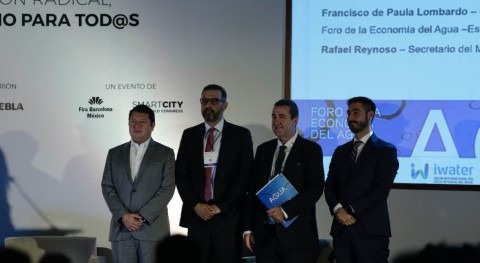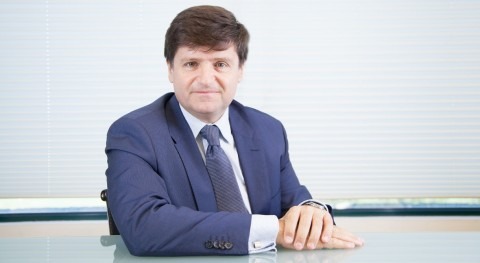Jerson Kelman, professor at the Federal University of Rio de Janeiro, is one of the speakers at the 11th Water Economy Forum that will be held on July 2nd in Puebla, Mexico, where he will participate in a session on resilience versus irreversibility in water services management in large metropolitan areas.
Kelman graduated in civil engineering from the Federal University of Rio de Janeiro (UFRJ), where he also did a Master of Science. Afterwards he did a PhD at the University of Colorado on water issues. Since 1974 he is a water resources professor at the COPPE-UFRJ, which is the UFRJ's graduate school of engineering. In the water sector, he has been the senior manager of SABESP — the State of São Paulo water utility, which provides services to 28 million people —, of the National Water Agency (ANA) and the Brazilian Water Resources Association (ABRH). He has also worked in the electric power sector, as the senior manager of LIGHT — the electric power company of Río de Janeiro — and the national Electric Power Agency (ANEEL).
Currently he is the Chairman of the Board of Directors of ENEVA — an electric power producing company — and member of the Board of Directors of IGUÁ — a water supply company — and EVOLTZ — an electric power distribution company. He also sits on the Advisory Boards of the Bank Federation (FEBRABAN) and the Brazilian Sustainable Development Foundation (FBDS).
Question: What are the water management challenges in Latin America's large metropolitan areas?
Answer: We are well into the 21st century, but more than 2 billion people across the world do not have sanitation. Worried about this, Bill Gates created an award to reinvent the toilet. With the traditional method, in use since the 19th century, a small amount of human waste is diluted in a large amount of water. The objective is to facilitate water flow inside pipes. Ideally, before reaching a river or the sea, the sewage goes through a waste water treatment plant that concentrates pollutants into 'sludge'. It is a high cost solution, due to the cost of the underground pipeline network and pumping stations, as well as the consumption of energy and reagents. Ongoing research to find an alternate solution focuses on treating waste as close to its origin as possible. Preferably, in the dwelling itself.
It would mean a potential success over the coming years, both in terms of technology and in financial terms, an important transformation in the sanitation sector — maybe similar to distributed electric power generation using solar panels in rooftops. But until this shift happens, we have to face reality with the existing technology.
In Brazil, only 60% of the urban population lives in dwellings connected to the sewerage network, and of the water collected, only 3/4 of the sewage collected undergoes treatment
Q: How about in Brazil in particular?
A: 160 million of Brazilians living in cities (93% of the urban population) have access to drinking water. It is a reasonable rate, the result of substantial investments throughout many years. But for a reasonable fraction of those 'happy' customers, service is precarious, both in terms of a constant supply and in terms of water quality. And there are still 12 million people (7% of the urban population) that still do not have access to drinking water.
The situation regarding sewage collection and treatment is much worse: only 60% of the urban population lives in dwellings connected to the sewerage network, and only 3/4 of the sewage collected undergoes treatment. This means that more than half of the sewage from cities flows into rivers untreated. It is not surprising that rivers crossing cities are very polluted.
The situation is worse in poor neighbourhoods, where, without a sewerage network, sewage flows through open drains, spreading contagious diseases, such as diarrhoea, as if we were in the Middle Ages. More than 50% of hospital admissions of children under 5 years old are due to this type of diseases. It is a deplorable situation, even if we compare it with other countries with a similar level of development as Brazil.
With current technology, waste water collection can use separate or combined sewers. In the first case, storm water and sewage flow through different sewers. In the second case, the same sewer conveys storm water and sewage combined. At the end of the 19th century, combined sewer systems were widely used in today's developed countries. However, through time, separate sewers became the norm, as they provide better results if they are properly installed and operated.
In Brazil, most cities have separate sewers. Nevertheless, because of faulty implementation, lack of monitoring by the government, and low social control, storm water and sewage end up mixed in the separate sewer system, which in turn works worse than a combined sewer system.
And so high amounts of untreated waste water are discharged into local water bodies, prompting the search of new water sources far from the point of demand
Q: What is the strategy in São Paulo to adapt to the challenges it faces as a large city?
A: The worse drought in the history of the São Paulo metropolitan region could have cause social discontent. The most important water reserve was below 5% of its storage capacity, what is known as the 'dead volume'. A combination of structural and non-structural measures, including important collaboration from the population to use water more efficiently, was essential to tackle the challenge. Emergency water infrastructure was implemented in record time, to allow a more flexible use of the eight reservoir systems in the region. Currently, the São Paulo metropolitan region is better prepared to address worse droughts than those anticipated in several water resource plans produced since the 1960s.
Based on a long data series and assuming steady conditions, the 2014-2015 event is so rare that one would be tempted to consider it an atypical value, with no relevant consequences for planning. However, a cautious decision maker must take into account that the hypothesis of steady conditions could be wrong due to changes in climate and land uses, and that it is wise to prepare for the recurrence of similar events. Therefore, SABESP decided to invest in new strategic infrastructure to ensure a regular water supply, even given an adverse situation such as the one experienced in 2014-2015.
Q: What do you expect from your participation in this XI Water Economy Forum?
A: I expect to explain further how we addressed the water crisis in São Paulo and primarily I expect to learn about providing sanitation services to impoverished populations from other experiences in Latin America. In the case of São Paulo, the water supply system operated by SABESP provides services to practically the entire population that lives in the officially urbanised São Paulo metropolitan region, where virtually all households have water meters. However, this is not the case for many of the informal settlements which are home to about 10% of the population. Most people have illegal and unpaid access to drinking water through precarious and wasteful distribution systems made up of small diameter plastic pipes connected to the network.
There are several barriers that prevent public water services from reaching these irregular settlements to provide regular service. Some have to do with legal disputes over land ownership (people have invaded private property), others have to do with environmental restrictions (people have invaded protected areas) and others, most of them, have to do with the impossibility of installing water supply and waste water collection systems in neighbourhoods where there are no roads to bury the pipelines. This messy urban development process started back in the 1950s, when only 30% of Brazil's population lived in cities, and then worsened, especially in the early 1970s, as industrialisation advanced.
In a few years, the urban population increased to 70% of the national population, but the expansion of infrastructure was much slower, giving rise to several problems. One of them is that high amounts of untreated waste water are discharged into local water bodies, prompting the search of new water sources far from the point of demand.









